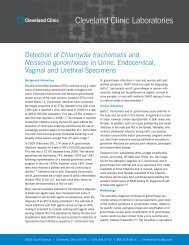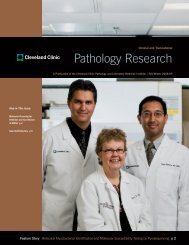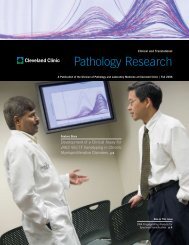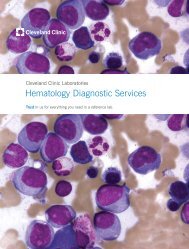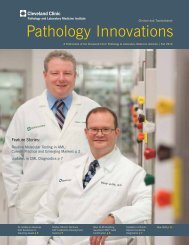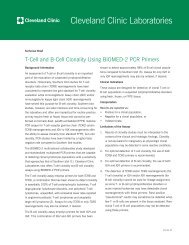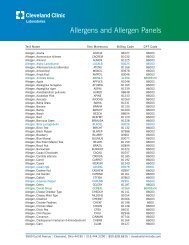Collagen Binding Activity Assay for Von Willebrand Disease
Collagen Binding Activity Assay for Von Willebrand Disease
Collagen Binding Activity Assay for Von Willebrand Disease
Create successful ePaper yourself
Turn your PDF publications into a flip-book with our unique Google optimized e-Paper software.
Cleveland Clinic Laboratories<br />
Technical Brief<br />
<strong>Collagen</strong> <strong>Binding</strong> <strong>Activity</strong> <strong>Assay</strong> <strong>for</strong> <strong>Von</strong> <strong>Willebrand</strong> <strong>Disease</strong><br />
Background In<strong>for</strong>mation<br />
<strong>Von</strong> <strong>Willebrand</strong> disease (VWD) is the most common<br />
inherited bleeding disorder with a prevalence of approximately<br />
1% in the general population. It also can occur<br />
as an acquired bleeding disorder. VWD is a clinically<br />
heterogeneous disorder with several subtypes due to<br />
deficiency and/or dysfunction of von <strong>Willebrand</strong> factor<br />
(VWF). VWF is a multimeric adhesive glycoprotein that<br />
plays a major role in primary hemostasis and coagulation.<br />
VWF mediates adhesion of platelets to injured sub-endothelium<br />
and to the platelet surface receptor GPIb and<br />
serves as the specific carrier protein <strong>for</strong> coagulation factor<br />
VIII (fVIII) in plasma preventing proteolytic degradation.<br />
The revised classification of VWD identified two major<br />
categories, quantitative and qualitative defects.<br />
The quantitative VWF defects include type 1 (partial<br />
deficiency of VWF) and type 3 (complete absence of<br />
VWF) in plasma and/or platelets. Type 2 is a qualitative<br />
VWF defect that is further classified as four subtypes by<br />
different pathophysiologic mechanisms.<br />
Accurate laboratory diagnosis and classification of VWD<br />
using both quantitative (antigenic) and qualitative (functional)<br />
assays based on the VWD diagnostic algorithm<br />
(see page 3) are crucial because the presenting biological<br />
activity of VWF determines both the hemorrhagic risk and<br />
subsequent clinical management.<br />
Clinical Indications<br />
The functional activity of VWF traditionally has been<br />
assessed using the ristocetin cofactor activity (RiCof)<br />
assay, which measures the VWF-mediated agglutination<br />
of platelets in the presence of ristocetin. However, the<br />
usefulness of this assay has limitations due to poor reproducibility<br />
and lack of calibration. The collagen binding<br />
activity (CBA) assay has been proposed as a supplemental<br />
test <strong>for</strong> VWF activity.<br />
The CBA assay is based on the ability of multimeric <strong>for</strong>ms<br />
of VWF to bind collagen, and its greatest strength lies in<br />
the ability to selectively detect primarily high molecular<br />
weight (HMW) <strong>for</strong>ms of VWF, which are known to be<br />
most functional and adhesive.<br />
The CBA assay is a useful adjunctive to the RiCof assay<br />
<strong>for</strong> the diagnosis of VWD and to differentiate VWD with<br />
deficiency of HMW multimer <strong>for</strong>ms in type 2A and type<br />
2B from type 1. It also can differentiate very low levels<br />
of VWF in severe type 1 from complete absence of VWF<br />
in type 3 and has been reported as a better marker <strong>for</strong><br />
therapeutic efficacy of treatment with DDAVP ® (desmopressin)<br />
and fVIII concentrate.<br />
Interpretation<br />
CBA results are reported as % of the reference value <strong>for</strong><br />
CBA. CBA to VWF:Ag ratio is calculated to provide a ratio<br />
of VWF activity to protein amount.<br />
1. Type 1 VWD patients have concordantly decreased<br />
CBA and VWF:Ag levels.<br />
2. Type 3 VWD patients have markedly decreased or<br />
nearly absent CBA and VWF:Ag levels.<br />
3. Type 2A VWD and type 2B VWD patients have<br />
discordantly decreased CBA and VWF:Ag levels with<br />
markedly decreased CBA level, normal or decreased<br />
VWF:Ag level and loss of HMW multimers.<br />
04.12.11
4. Type 2M VWD patients have a discordantly decreased<br />
CBA level with a normal or decreased VWF:Ag level<br />
but without the loss of HMW multimers.<br />
5. Type 2N VWD patients have normal CBA and VWF:Ag<br />
with discordantly decreased FVIII coagulant activity.<br />
6. CBA values are known to be lower in O blood groups<br />
compared with non-O blood groups. However, as<br />
VWF:Ag levels show similar blood group dependence,<br />
the ratio of CBA/VWF:Ag is not affected.<br />
Methodology<br />
The CBA assay is an enzyme immunoassay (REAADS ®<br />
<strong>Collagen</strong> <strong>Binding</strong> <strong>Assay</strong> ELISA kit, Corgenix, Inc.,<br />
Broomfield, Colo.) that quantitates the binding of VWF<br />
to a collagen-coated microwell plate. After binding<br />
peroxidase-conjugated anti-VWF antibodies to VWF<br />
multimers, the resulting color intensity is determined<br />
photometrically, which is proportional to HMW <strong>for</strong>ms of<br />
VWF present in the plasma. In situ evaluation <strong>for</strong> precision<br />
and accuracy of the CBA assay shows low coefficient of<br />
variation (6.3-11.1%) with lower limit of detection 0.2%<br />
(linearity 1-530%).<br />
Specimen Collection and Handling<br />
Collection of blood by routine venipuncture in a 3.5ml<br />
light blue top tube containing 9:1 ratio of blood to 3.2%<br />
trisodium citrate anticoagulant.<br />
Specimens other than 3.2% trosodium citrate plasma and<br />
those that are improperly collected, stored, misidentified<br />
or of insufficient volume are unacceptable. Also refer to<br />
“Criteria <strong>for</strong> rejection and special handling of coagulation<br />
specimens.”<br />
Suggested Reading<br />
1. Favaloro EJ. <strong>Von</strong> <strong>Willebrand</strong> factor collagen-binding<br />
(activity) assay in the diagnosis of von <strong>Willebrand</strong><br />
disease: a 15-year journey. Seminar Thromb Hemost.<br />
2002;28:191-202.<br />
2. Nichols WL et al. The diagnosis, evaluation, and<br />
management of von <strong>Willebrand</strong> disease. U.S. Department<br />
of Health and Human Services. NIH Publication<br />
No. 08-5832, December 2007.<br />
3. Castaman G, Federici AB, Rodeghiero F, Mannucci<br />
PM. <strong>Von</strong> <strong>Willebrand</strong> disease in the year 2003: toward<br />
the complete identification of gene defects <strong>for</strong> correct<br />
diagnosis and treatment. Haematologica.<br />
2003;Jan;88(1):94-108.<br />
4. Kalla A, Talpsep T. The von <strong>Willebrand</strong> factor collagenbinding<br />
activity assay: clinical application. An Hematol.<br />
2001;80:466-471.<br />
5. Favaloro EJ. Toward a new paradigm <strong>for</strong> the identification<br />
and functional characterization of <strong>Von</strong> <strong>Willebrand</strong><br />
disease. Seminar Thromb Hemost. 2009;35:60-75.<br />
Pediatric volume of 2.5ml with an appropriate ratio of<br />
anticoagulant is acceptable.
DIAGNOSTIC ALGORITHM FOR VON WILLEBRAND PANEL<br />
PT, APTT, PFA-100, RIPA, platelet count, fVIII:C; VWF:Ag; VWF:RiCof +/-VWF:CBA<br />
All normal<br />
PFA-100 abnormal,<br />
other tests normal<br />
PT &/or PTT abnormal,<br />
other tests normal<br />
VWF:Ag, RiCof, fVIII or<br />
CBA abnormal (+/- PFA-100)<br />
Suspicion low –<br />
No further testing<br />
Suspicion high –<br />
Repeat testing and<br />
do platelet function<br />
testing<br />
Do platelet<br />
aggregation to R/O<br />
platelet dysfunction<br />
Evaluate non-VWF &<br />
non-fVIII mechanism of<br />
abnormal PT &/or PTT<br />
VWF:Ag and CBA/RiCof<br />
concordant decrease<br />
Note: if RiCof is Low,<br />
per<strong>for</strong>m CBA<br />
VWF:Ag > fVIII or<br />
VWF:Ag > CBA/RiCof<br />
(discordant decrease)<br />
VWF Ag and Rist cofactor<br />
low-nl: VWD indeterminate<br />
All low (
Cleveland Clinic Laboratories<br />
9500 Euclid Avenue, L15, Cleveland,Ohio 44195<br />
800.628.6816 | www.clevelandcliniclabs.com<br />
Test Overview<br />
Test Name<br />
<strong>Collagen</strong> <strong>Binding</strong> <strong>Activity</strong> <strong>Assay</strong><br />
Reference Range CBA: 41-161%; Ratio of CBA/VWF:Ag >=0.73<br />
Specimen Requirements<br />
Specimen Collection and Handling<br />
Test Ordering In<strong>for</strong>mation<br />
Testing Volume/Size: 2 mL; Type: Plasma; Tube/Container: Sodium citrate (lt. blue); Transport<br />
Temperature: Centrifuge, aliquot and freeze.<br />
Collection of blood by routine venipuncture in a 3.5ml light blue top tube containing 9:1 ratio of<br />
blood to 3.2% trisodium citrate anticoagulant.<br />
Pediatric volume of 2.5ml with an appropriate ratio of anticoagulant is acceptable.<br />
Specimens other than 3.2% trosodium citrate plasma and those that are improperly collected,<br />
stored, misidentified or of insufficient volume are unacceptable. Also refer to “Criteria <strong>for</strong> rejection<br />
and special handling of coagulation specimens.”<br />
3.2% sodium citrate is the preferred anticoagulant recommended by CLIS. Order VWF panel <strong>for</strong><br />
further evaluation and classification.<br />
Billing Code 87899<br />
CPT Code 83520<br />
Technical In<strong>for</strong>mation Contact:<br />
Tim Paustian, MT(ASCP)<br />
216.445.1862<br />
paustit@ccf.org<br />
Scientific In<strong>for</strong>mation Contacts:<br />
Joyce Heesun Rogers, MD, PhD<br />
216.445.2719<br />
rogersj5@ccf.org<br />
Kandice Kottke-Marchant, MD, PhD<br />
216.444.2484<br />
marchak@ccf.org<br />
201103.28



